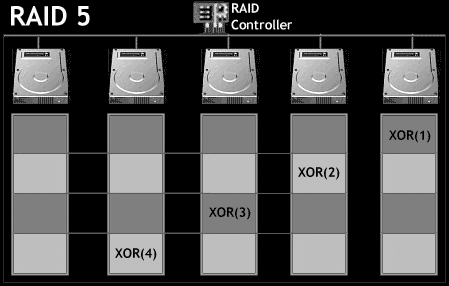RAID 5 performance is all about the RAID controller. Depending on implementation and the controller in use, it can offer a data read transaction rate as formidable as any RAID level, an impressive write transaction rate, and an excellent aggregate transfer rate. What it offers that RAID 0 doesn’t is security. By ideal design, only one “virtual” parity disk is assigned to each array. Each entire data block is written on a data disk; parity for blocks in the same rank is generated on writes, recorded in a distributed location and checked on reads.
How can RAID 5 perform on par with RAID 0 on a read operation? Theoretically it cannot. But on closer evaluation, we’ll see why it’s so powerful. Put simply, this configuration fully incorporates both data striping & parity, and is thus a popular alternative for server solutions, especially in the Windows world. Notice the “virtual” up there. If RAID 3 was good, RAID 5 is even better because now the parity information is written out all over the array, and not just on a single disk. This is great because it greatly reduces the kind of bottleneck that you’d experience with a single-parity-disk solution.

Multiple writes and reads can occur simultaneously, without stepping on each other’s toes. As the number of disks go up, so do the potential number of reads/writes that can occur simultaneously. In the real world you’ll find that RAID 5 configurations on a quality RAID controller can actually be as fast as RAID 0 implementations because of their predictability and their read cache performance. Your write performance will be dependent on your controller’s cache. As opposed to RAID 0, RAID 5 needs a large cache to write at an acceptable rate.
In addition, with the onset of “hot-swappable” disks, we can easily swap good & bad drives in this configuration with minimal chance of data loss, while the system is running, and the RAID controller reconstructs the missing data via the parity information stored on the other disks.